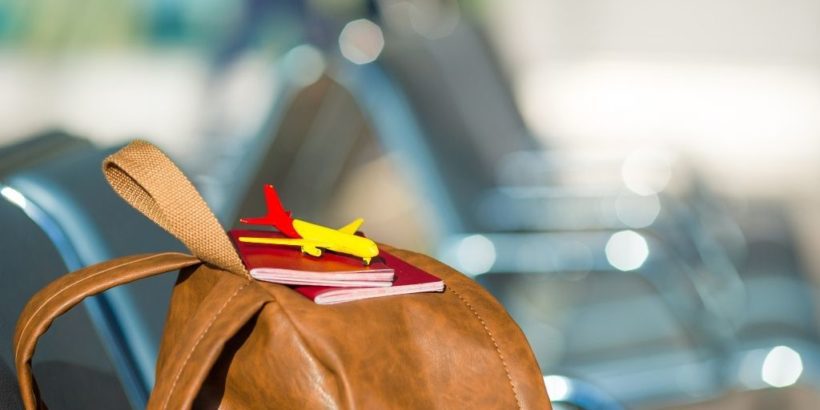What exactly counts as a personal item on a plane? For example, can you get away with a backpack or duffel bag even if it might be slightly over the allowed dimensions?
Before heading out to the airport, you want to make sure that you have a good understanding of what counts as a personal item because it could cause you issues and potentially affect your ability to board your plane.
In this article, I’ll go in depth and explain to you exactly what a personal item is and answer a lot of common questions travelers have.
Table of Contents
What is a personal item on a plane?
Personal items are small bags such as backpacks and purses or individual items like laptops and cameras that are generally allowed on a plane in combination with your carry-on item. These are typically stored underneath the seat in front of you although some items may be okay to keep in your lap during the flight.
Keep reading to find out more about the rules for carrying personal items on planes and also to see what items count as free “bonus” items.
Tip: Use the free app WalletFlo to help you travel the world for free by finding the best travel credit cards and promotions!
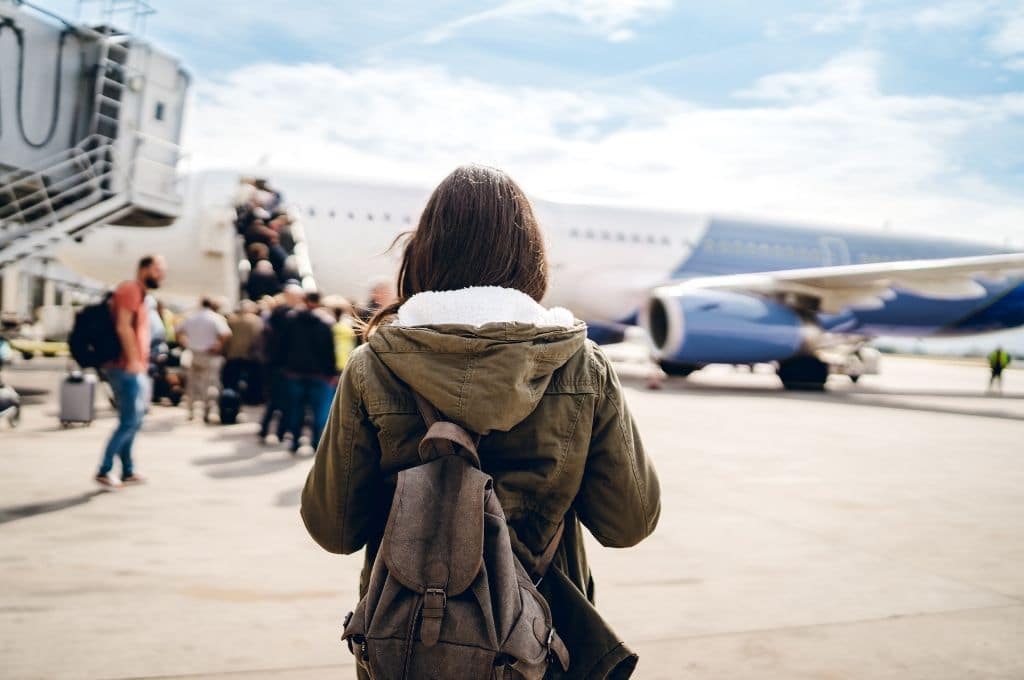
Rules for personal items
Where to find the rules
You generally will find the rules for personal items on the carry-on page on an airline’s website.
Size dimensions
Airlines will often publish specific size dimensions for your personal item and also state that it must fit under the seat beneath you. The size dimensions for personal items are different for almost every airline in the US as you can tell below.
Here’s a rundown of the size policies for major airlines in the US.
United Airlines states:
Your personal item should fit underneath the seat in front of you. The maximum dimensions for your personal item are 9 inches x 10 inches x 17 inches (22 centimeters x 25 centimeters x 43 centimeters).”
American Airlines states:
Your personal item like a purse or small handbag must fit under the seat in front of you. Dimensions should not exceed 18 x 14 x 8 inches (45 x 35 x 20 cm).
JetBlue states:
All fares include 1 personal item that fits under the seat in front of you. This could be a purse, daypack, laptop bag or approved pet carrier. Personal items cannot exceed 17″ L (43.2 cm) x 13″ W (33 cm) x 8″ H (20.32 cm).
Southwest Airlines states:
Personal-type items include purses, briefcases, cameras, food containers, or laptops (case included). Your personal item must be stored under the seat in front of you, fitting within 18.5 x 8.5 x 13.5 inch dimensions
Spirit Airlines states:
Personal item (e.g., purse, small backpack, etc.): Dimensions must not exceed 18 x 14 x 8 inches (45 x 35 x 20 cm) including handles and wheels.
Frontier Airlines states:
Personal items can be no larger than 14” tall, 18” wide, and 8” long. Personal items must fit completely within the personal item portion of the bag sizer. Think purses, totes, computer bags, briefcases, diaper bags and kids backpacks!
Allegiant states:
Your Personal Item (like a purse, briefcase, or a small backpack) must be stored completely underneath the seat in front of you.
Maximum dimensions are 7 x 15 x 16 inches (17.8 x 38.1 x 40.6 centimeters)
I’ve been on hundreds of flights over the years in the US with various carriers including United, Southwest, American, and Delta. I’ve never seen a crew member measure a personal item.
I’m not saying it doesn’t happen (especially on budget airlines) but as long as you can fit your personal item under the seat in front of you (without stuffing it with your legs and causing some commotion), you should be okay.
The major caveat here is when dealing with budget airlines like Frontier and Spirit. These airlines tend to be more strict when it comes to the size of your carry-on and personal items.
They often even have measurement baskets (“sizers”) at the gate for you to place your bag and see if it complies with the size dimensions for both carry-ons and personal items.
I would definitely err on the side of going small with your personal item when flying those airlines.
Airlines that don’t provide specific dimensions
Not every airline provides specific dimensions. For example, here is what Delta Airlines states about its personal items:
“Approved Personal Items| Bringing a personal item? Pick an item like this or of a similar size to store beneath the seat in front of you during your flight.
- 1 purse, briefcase, small backpack, camera bag or diaper bag
- 1 laptop bag (computers cannot be checked, unless directed to by security)
- 1 item of similar or smaller size to those listed”
(Similar size items would be things like fanny packs.)
Alaska Airlines states:
You’ll still be allowed one carry-on bag and one personal item such as a purse, briefcase, or laptop bag.
Hawaiian Airlines states:
Your allotted personal item must be small enough to fit safely under the seat in front of you. Personal items are generally such things as a purse, briefcase, laptop computer, small backpack, or similar piece. In each case, it must fit safely under the seat in front of you.
So the common theme is that your personal item just needs to fit underneath the seat in front of you.
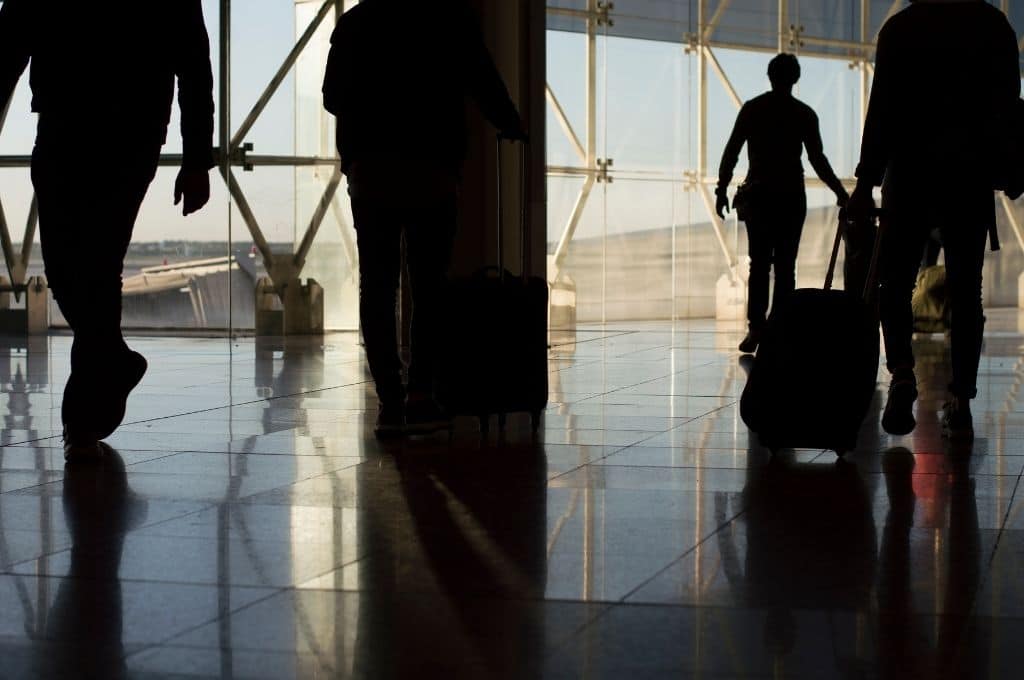
Weight measurements
Some airlines apply weight restrictions to carry-on bags while others even explicitly state that there is no weight requirement. I don’t think I’ve ever seen a published weight requirement for personal items, though they could exist.
It makes sense there would not be weight restrictions for personal items because it would be rare for a flight attendant to ever need to engage in heavy lifting to assist you with putting a personal item under your seat, although some people do put personal items in the overhead storage bins.
Bonus personal items
A lot of airlines will allow you to bring items that don’t count as a carry-on and a personal item. I consider these to be bonus personal items and you can usually find a list of these on the airlines website (some other airlines call them “free items” or “ancillary items”).
One of the most common bonus items is food which — contrary to what many travelers think — can be brought through TSA.
But there are quite a few other items as well.
For example, here are some of the items listed by United:
- A jacket
- An umbrella
- Reading material
- Food or merchandise that you buy in the airport
- Assistive devices (such as a collapsible wheelchair, cane, crutches, medical device for prescription medications, or portable oxygen concentrator)
- FAA-approved child restraint system or safety seat
- A diaper bag
- A breast pump
- A camera
- A pet carrier (service charges apply for in-cabin pets)
Here’s what American Airlines says:
“Diaper bags (1 per child), soft-sided cooler bags with breast milk, child safety seats, strollers and medical or mobility devices don’t count as your personal item or carry-on.”
Here are the items listed by Delta:
- A jacket and/or umbrella
- Food or drink purchased past the security checkpoint
- Duty-free merchandise
- Special items like strollers, wheelchairs, child safety seats or assistive devices like crutches
Here are the ancillary items listed by Hawaiian Airlines:
- a handbag or pocketbook;
- an overcoat, jacket or wrap;
- a small foot rug;
- an umbrella or walking stick;
- a camera and/or a pair of binoculars;
- a reasonable amount of reading matter for the flight; and
- food (includes baby food) for consumption on the flight.
Typically, a standard travel pillow would also fall under this bonus item category, as I’ve traveled with my carry-on + personal item + travel pillow with zero issues dozens of times.

Two personal items
If you’re allowed a carry-on then you should be able to bring two personal items no problem since one of your personal items can essentially qualify as your carry-on.
But if you don’t have a free carry-on, you might run into trouble.
If you’re not allowed to bring on a free carry-on, you should still be able to bring on a personal item plus a bonus personal item.
But if you are trying to bring two backpacks and you don’t have an allowance for a carry-on bag, there is a high chance you will run into trouble.
If your two personal items are small (can both fit under your seat) and that’s all your carrying, you might be able to bring both of those items but airlines don’t like having a lot of loose items on board for safety purposes, so you might get some resistance.
Related: TSA Pre-Check Guide (Application Process, Locations, Status)
Commonly asked about personal items
Backpacks
When an airline does not provide an exact measurement for personal items, a common question is what constitutes a “small backpack?”
In my personal experience, a small backpack can include a normal-sized backpack. Indeed, I just flew Delta in the fall of 2021 with my North Face backpack of normal book bag size and had no issues.
If your normal sized backpack is packed to the max or you have a larger backpack (like a backpacking backpack), that’s probably when you start to run into issues.
You might also run into more issues with the budget airlines who could be more strict about the size of your personal items.
Dozens and dozens of online reports indicate people have had success bringing normal-sized backpacks as personal items on budget airlines like Spirit.
This is despite the fact that some of those backpacks were a bit larger than the allowed dimensions and despite the fact that airlines like Spirit, Allegiant, and Frontier have a reputation for being strict on personal items.
It seems that as long as your backpack is not abnormally large and can potentially be squished down to fit below a seat, even budget airlines will be okay with you bringing your (normal-sized) backpack.
But just remember that you are at the mercy of the gate agent. If he or she feels like being a stickler, they could give you a hard time.
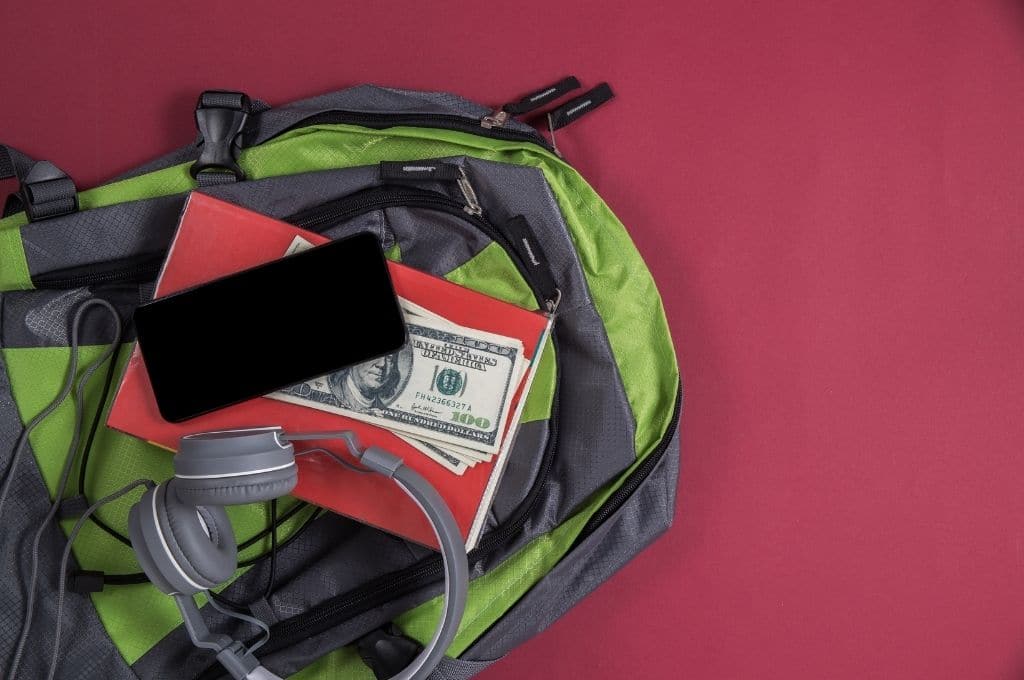
Duffel bags
Duffel bags come in a lot of different sizes. A small duffel bag should easily fit under your seat and could be considered a personal item.
However, larger duffel bags look more like carry-on bags and could present a problem for some airlines, especially those budget airlines.
But again, if you can squish it down underneath the seat in front of you relatively easy your chances of encountering an issue are probably pretty minimal.
One tip for carrying a duffel bag is to put it over your shoulder and carry it around like someone would carry a purse. This could make the bag look even smaller especially if you have the bag on the opposite side of the gate agent.
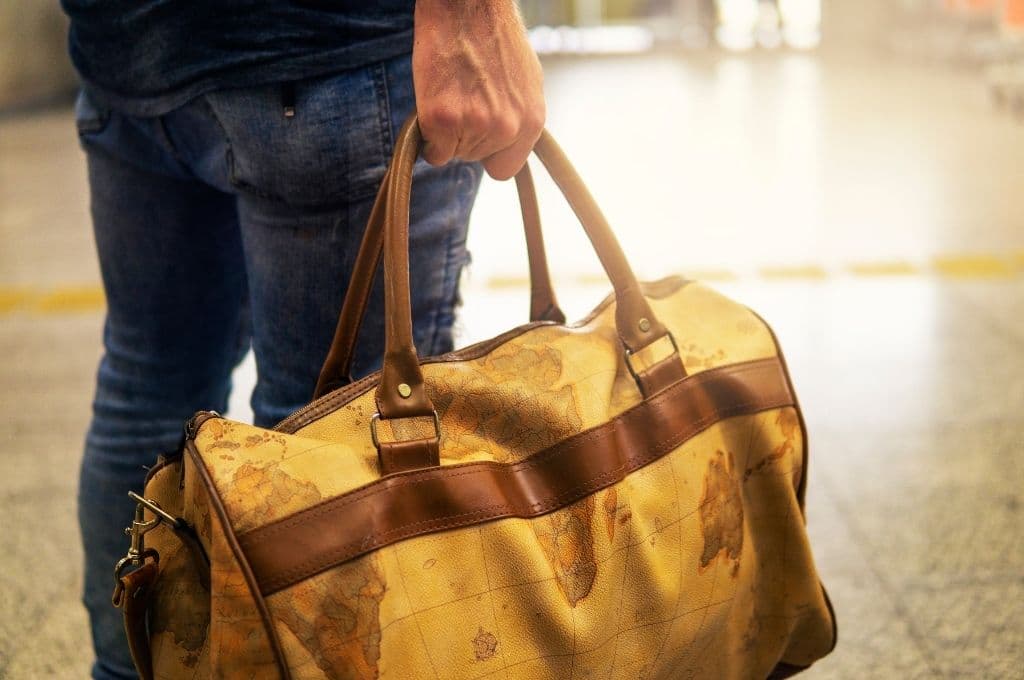
What can you pack or put in your personal item?
You can put virtually anything in your personal item as long as it complies with the airline’s policies and TSA rules.
Most people will probably find it easier to access their liquids from a personal item rather than a carry-on which will make it easier to get through security (but it really just depends on your luggage set up).
Also, I always make sure to include items that I regularly access throughout the flight in my personal item. This could be snacks, drinks, medications, headphones, chargers, etc.
It’s worth mentioning that for the most part TSA rules and airline policies are aligned. In other words, if TSA allows you to bring the item the airline will generally allow you to bring it as well.
But that is not always the case which is why sometimes you need to check with the individual airline.
Related: TSA Checklist (Tips & PDF)
Basic economy
Basic economy fares are the cheapest type of tickets you can purchase for some airlines.
While cheap, these come with restrictions such as not allowing you to choose your seat or restricting the carry-on luggage you can bring on board.
Typically, a basic economy fare will only restrict your carry-on bag and you will still be allowed to bring on a personal item for free.
Emergency exit row seats and bulkhead
If you choose to fly in the emergency exit rows or in the bulkhead, you may have to store your personal item in the overhead storage bin. That’s because there may be no seat in front of you for you to slide your bag under.
If you are one of the last people to board it’s possible that the overhead storage bin will already be full near your seat.
This means you will have to go hunt down some open space somewhere in the cabin or in a worst-case scenario, you might not find any space and have to ask the flight attendant about your options.
There is always that possibility that your bag will have to be checked if there is no room so I always try to be one of the first to board when sitting in those seats.
Personal items FAQ
Budget airlines like Frontier, Spirit, and Allegiant may check your personal item to make sure that it complies with size requirements. However, many passengers never have their personal item checked for size.
Each airline has its own size dimensions for personal items. However, the general rule of thumb is that if it can easily fit under your seat, it is not too big.
A normal-sized backpack can constitute a personal item for most US airlines.
Bringing along a personal item should be free on virtually every airline even if you have booked a basic economy ticket.
Most airlines do not publish weight requirements for personal items.
Final word
Virtually every airline will allow you to bring a personal item on the plane for free. The size requirements will be different for each airline and each airline will allow free bonus items as well. But as long as you can fit your personal item beneath your seat without any issues, you will most likely be fine.
Daniel Gillaspia is the Founder of UponArriving.com and the credit card app, WalletFlo. He is a former attorney turned travel expert covering destinations along with TSA, airline, and hotel policies. Since 2014, his content has been featured in publications such as National Geographic, Smithsonian Magazine, and CNBC. Read my bio.

